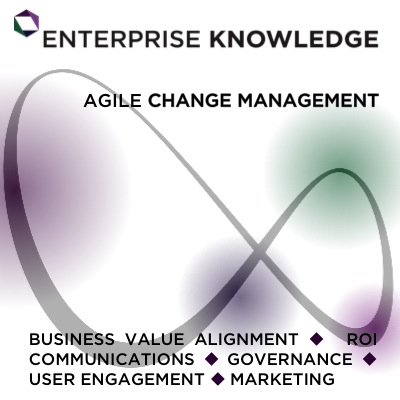 Through our years of designing, developing, and implementing knowledge and information management technologies, we’ve consistently regarded user understanding and buy-in as key criteria for success. The change management profession aims to reduce the purported 70% failure rate on large projects by concentrating on the people side of change. Change professionals focus on communications, training, and stakeholder engagement activities for projects ranging from the rollout of a new document management system to a new records retention process to a corporate reorganization.
Through our years of designing, developing, and implementing knowledge and information management technologies, we’ve consistently regarded user understanding and buy-in as key criteria for success. The change management profession aims to reduce the purported 70% failure rate on large projects by concentrating on the people side of change. Change professionals focus on communications, training, and stakeholder engagement activities for projects ranging from the rollout of a new document management system to a new records retention process to a corporate reorganization.
Typically, change management activities are aligned with project management activities, and change professionals often sit in a Program Management Organization (PMO). A traditional, or waterfall, project involves determining all requirements in advance and choosing a go-live date based on expected level of effort, with little tolerance for adjustments along the way. Change management for a waterfall project might include a large upfront stakeholder analysis, a one-time training push, and a PR campaign timed around a go-live date.
However, most of the projects in need of change management activities, including knowledge and information management (KIM) projects, tend to be long and complex. This makes “big” upfront change management a risky proposition. No organization is in a static state, so findings from an initial stakeholder analysis may be invalid by the time the project is ready to launch. At this point, change managers often have very little ability to accurately predict successful user adoption. And once the project is live, it’s too late.
How can you ensure your change management approach resonates? Take an Agile approach.
Agile software development aims to reduce risk by taking an iterative, incremental approach to building a product. By engaging users on a regular basis to gain feedback, teams have regular opportunities to correct course and ultimately deliver a more successful product. At EK, we take the same approach with user adoption initiatives, allowing them to adapt along with user needs and new information.
It’s important that the first adoption initiative is Agile adoption; that is, the project team needs to adopt the Agile mindset before other change management activities take place. This has an added value of driving Agile Transformation within an organization, yielding improved methodologies for system design, development, and implementation from end to end.
Once teams have gone Agile, change management activities on the project can begin to take place. This is a new experience for many change practitioners, since the profession has typically been aligned with waterfall. Indeed, we’ve commonly seen organizations that call themselves or their projects Agile, but are actually just doing waterfall but employing loosely actualized Agile terms. But as evinced by content at a recent conference put on by the Association of Change Management Professionals (ACMP), change management practices need to evolve to keep pace with an Agile environment.
But how do you effect change iteratively? Change management for Agile projects has many similarities with Agile Marketing, which focuses on taking an iterative approach to content production. By keeping communications activities bite-sized, change professionals can focus on measuring the effectiveness of content and minimize wasted effort. It’s also key to set up a robust feedback mechanism to involve stakeholders early on in the project. Next, change managers should focus on collaborating to design an intuitive product or process rather than extensive training. Finally, change professionals must reflect on their own process regularly, allowing space for innovation and improvement.
The bottom line: By iterating often, change professionals can align themselves more closely with the direction of the project, take into account shifting priorities and ultimately, have a better chance of successful user adoption.
Still struggling with Agile adoption? Contact EK or check out some more tips and tricks from one of our recent presentations.
